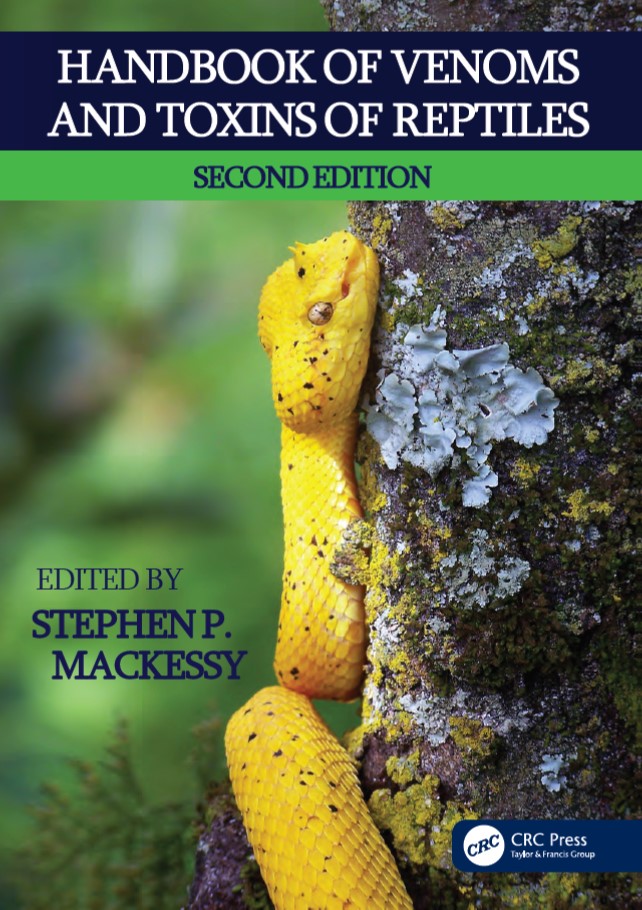
School of Biological Sciences
Natural and Health Sciences
My academic background included coursework and research in evolution/ecology as well as biochemistry/toxinology, and this broad foundation allows me to utilize an integrated approach in both my teaching and research. I teach several graduate and undergraduate courses in biomedicine (Toxinology [Biology 565], Current Topics in Biomedical Research [Biology 556], Human Anatomy [Biology 341], Parasitology [Biology 333/533]) and vertebrate biology (Herpetology [Biology 335/535], Comparative Anatomy [Biology 345]) at UNC. As part of their training in Biological Sciences, many undergraduate students have participated in independent research in my lab [Biology 422]; several of these students were coauthors on peer-reviewed publications, and many have continued on in graduate and professional programs and careers.
The general focus of much of my research is on venomous snakes and their venoms; however, particular research projects involve very different aspects of the biology of these remarkable animals, ranging from functional biochemistry to population molecular genetics to natural history/ecology. It is my opinion that an interdisciplinary approach to research can offer the best possibility of understanding an organism and mechanisms of its interactions with its environment, and so my research and that of my students utilizes this multifaceted approach. Below are elaborations of specific projects in progress.
A webinar produced summer of 2018 that discusses some aspects of venom composition and effects of these components on living tissues can be found here: Reptile venoms - composition and action Please note that figures and photographs are proprietary and copyright SP Mackessy 2021.

*UNC graduate student; **UNC undergraduate student
Smith, C.F. Baldé, M.A., Bahrabadi, L., Amponsah-Asamoah, M., Larson, K.Y., Maroney, S.P., Ceja-Galindo, D., Millimouno, M., Camara, N., Benjamin, J., Brandehoff, N.P., Modahl, C.M., McCabe, M.C., Cohen, M.J., Castoe, T.A., Baldé, C., Jackson, K., Mackessy, S.P., Hansen, K.C., Saviola, A.J. 2024. Discerning specific thrombolytic activities and blood clot degradomes of diverse snake venoms with untargeted peptidomics. BioRxiv https://doi.org/10.1101/2024.08.30.610527
Meik, J., Watson, J., Schield, D., Perry, B., Francioli, Y., Guss, H., Mackessy, S.P., Castoe, Todd. 2024. Climatic temperature and precipitation jointly influence body size in species of western rattlesnakes. Royal Society Open Science 11(8):240345. 10.1098/rsos.240345
Gopalan SS, Perry BW, Francioli YZ, Schield DR, Guss HD, Bernstein JM, Ballard K, Smith CF, Saviola AJ, Adams RH, Mackessy SP, Castoe TA. 2024. Diverse gene regulatory mechanisms alter rattlesnake venom gene expression at fine evolutionary scales.Genome Biology and Evolution (in press). https://academic.oup.com/gbe/advance-article/doi/10.1093/gbe/evae110/7675271?searchresult=1
Smith, C.F., Modahl, C.M., Ceja-Galindo, D., Larson, K.Y., Maroney, S.P., Bahrabadi, L., Brandehoff, N.P., Perry, B.W., McCabe, M.C., Petras, D., Lomonte, B., Calvete, J.J., Castoe, T.A., Mackessy, S.P., Hansen, K.C., SaviolaY A.J. 2024. Assessing target specificity of the small molecule inhibitor marimastat to snake venom toxins: A novel application of thermal proteome profiling. Molecular & Cellular Proteomics 23 (6): 100779. https://www.mcponline.org/article/S1535-9476(24)00069-0/fulltext
Balchan*, N.R., Smith, C.F., Mackessy, S.P. 2024. A plethora of rodents: Rattlesnake predators generate unanticipated patterns of venom resistance in a grassland ecosystem. Toxicon X 21:100179. https://www.sciencedirect.com/science/article/pii/S2590171023000310?via%3Dihub
Nikolakis, Z.L., D.R. Schield, A.K. Westfall, B.W. Perry, K.N. Ivey, R.W. Orton, N.R. Hales, R.H. Adams, J.M. Meik, J. Parker, C.F. Smith*, Z. Gompert, S.P. Mackessy, and T.A. Castoe. 2022. Evidence that genomic incompatibilities and other multilocus processes impact hybrid fitness in a rattlesnake hybrid zone. Evolution 76 (11):2513-2530. https://doi.org/10.1111/evo.14612
Schield, D.R., B.W. Perry, D.C. Card, G.I.M. Pasquesi, A.K. Westfall, S.P. Mackessy, and T.A. Castoe. 2022. The rattlesnake W chromosome: A GC-rich retroelement refugium with retained gene function across ancient evolutionary strata. Genome Biology and Evolution 14(9). https://doi.org/10.1093/gbe/evac116
Mukherjee, A.K., S.P. Mackessy. 2021. Prevention and improvement of clinical management of snakebite in Southern Asian countries: A proposed road map.Toxicon 200:140-152. https://authors.elsevier.com/c/1dTrq_xhNNfHi
Jucá, TL, Oliveira Normando LR, Ibrahim AB, Chapeaurouge A, de Oliveira Monteiro-Moreira, AC, Mackessy SP. 2021. Drought, desertification and poverty: a geospatial analysis of snakebite envenoming in the Caatinga biome of Brazil.International Journal of Health Planning and Management 36:1-12. https://onlinelibrary.wiley.com/doi/full/10.1002/hpm.3180
Schield, D.R., B.W. Perry, Z.L. Nikolakis, S.P. Mackessy, T.A. Castoe. 2021. Population genomic analyses confirm male-biased mutation rates in snakes.Journal of Heredity 112(2):221-227. https://doi.org/10.1093/jhered/esab005
Balchan*, N.R., S.P. Mackessy. 2021. Sistrurus tergeminus edwardsii (Desert Massasauga). Reproduction.Herpetological Review 52(2):433-434.
Heyborne, W.H., S.P. Mackessy. 2021. Venoms of New World vinesnakes (Oxybelis aeneus and O. fulgidus).Toxicon 190:22-30. https://www.sciencedirect.com/science/article/abs/pii/S0041010120309491
Sánchez, MN, Teibler, GP, Sciani, JM, Casafus, MG, Maruñak, SL, Mackessy, SP, Peichoto, ME. 2019. Unveiling toxicological aspects of venom from the Aesculapian False Coral Snake Erythrolamprus aesculapii. Toxicon 164:71-81. PDF https://www.sciencedirect.com/science/article/pii/S0041010119301199
Rex*, CJ, Mackessy, SP. 2019. Venom composition of adult Western Diamondback Rattlesnakes (Crotalus atrox) maintained under controlled diet and environmental conditions shows only minor changes. Toxicon 164:51-60. PDF https://www.sciencedirect.com/science/article/pii/S0041010119301126
Brandehoff N, Smith* CF, Buchanan JA, Mackessy SP, Bonney CF. 2019. First reported case of thrombocytopenia from a Heterodon nasicus envenomation.Toxicon 157:12-17. PDF https://doi.org/10.1016/j.toxicon.2018.11.295
Strickland JL, Smith* CF, Mason AJ, Borja M, Castañeda-Gaytán G, Schield DR, Castoe TA, Spencer CL, Smith LL, Trápaga A, Bouzid NM, Campillo-García G, Flores-Villela OA, Antonio-Rangel D, Rokyta DR, Mackessy SP, Parkinson CL. 2018. Evidence for divergent patterns of local selection driving venom variation in Mojave Rattlesnakes (Crotalus scutulatus). Scientific Reports 8:17622. PDFhttps://www.nature.com/articles/s41598-018-35810-9
Kalita B, Mackessy SP, Mukherjee AK. Biochemical and proteomic analyses reveal geographic variation in venom composition of Russell’s Viper in the Indian subcontinent: Implications for clinical manifestations post-envenomation and antivenom treatment. Expert Review of Proteomics 15:837-849. PDF https://doi.org/10.1080/14789450.2018.1528150
Mukherjee, A.K., S. Dutta, B. Kalita, D.K. Jha, P. Deb, S.P. Mackessy. 2016. Structural and functional characterization of complex formation between two Kunitz-type serine protease inhibitors from Russell’s Viper venom. Biochimie 128-129:138-147.PDF
Modahl*, C.M., S.P. Mackessy. 2016. Full-length venom protein cDNA sequences from venom-derived mRNA: exploring compositional variation and adaptive multigene evolution. PLoS Neglected Tropical Diseases 10(6): e0004587. doi:10.1371/journal.pntd.0004587. PDF
Mackessy, S.P., A.J. Saviola*. 2016. Venoms from “non-venomous” snakes: rear-fanged snake venoms as sources of novel compounds. In: Utkin, Y., Krivoshein, A.V. (eds.), Snake Venoms and Envenomation: Modern Trends and Future Prospects. p. 23-51. Nova Science Publishers, Inc., New York.
Modahl* C, AJ Saviola*, SP Mackessy. 2015. Proteomic and genomic approaches to the study of rear-fanged (“colubrid”) snake venoms. In: Gopalakrishnakone, P. (ed.), Handbooks of Toxinology. Venom genomics and proteomics. 23 p. Springer Science, Dordrecht.PDF